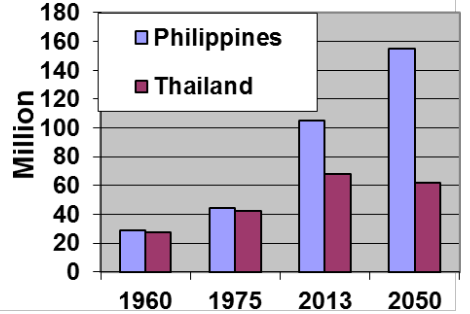1960 Philippines 28.5 million (3.05%/yr.) — Thailand 27.5 million (3.25%/yr.)
1975 Philippines 44.3 million (2.81%/yr.) — Thailand 42.3 million (2.65%/yr.)
1975 – Thailand initiates effective family planning programs; Philippines: none
2018 Philippines 105.9 million — Thailand 68.6 million
(1960-2018 – over 360% Philippines population increase)
Thailand: World’s top exporter of rice per capita basis
2013 Gross annual income US$5,400 (#97)
Philippines: World’s top importer of rice per capita basis
2013 Gross annual income US$2,400 (#130)
In the year 2050 Philippines 155 million people!!! Thailand 62 million people*
* Source: US Census Bureau-Internal Data Base; CIA World Fact Book
(Note: Philippine Commission on Population lists 98.7 million people for 2013-a discrepancy of about 7 million. There are also an additional 12 million overseas Filipino workers)
Without an effective family planning program there will be an additional 50 million babies born in the Philippines in the next 37 years (between 2014-2050).
 The more than 20,000 babies presently being born every month in the core Typhoon Haiyan (Yolanda) disaster-ravaged areas provide a preview of the suffering of the 50 million still unborn additional children and their mothers. Any disaster mitigation planning and reconstruction efforts – to be effective – must address this looming 50 million Filipino humanitarian crisis.
The more than 20,000 babies presently being born every month in the core Typhoon Haiyan (Yolanda) disaster-ravaged areas provide a preview of the suffering of the 50 million still unborn additional children and their mothers. Any disaster mitigation planning and reconstruction efforts – to be effective – must address this looming 50 million Filipino humanitarian crisis.
Information compiled from public records by
Rotary International – Club 75507 Multinational Manila (District 3810)
www.rotarymm.org
Interactive Flagship Programs:
- Maternal and Child Care, Basic Education, Literacy
- Economic and Community Development
- Family Planning-Responsible Parenthood-Women Empowerment
- Environmental Protection
- Disaster Mitigation
- Mitigation of Poverty and Hunger
The rapidly increasing world population is leading to serious conflicts about controlling the ocean’s resources such as harvesting its dwindling fisheries and mining its potentially lucrative minerals (East China Sea conflict).